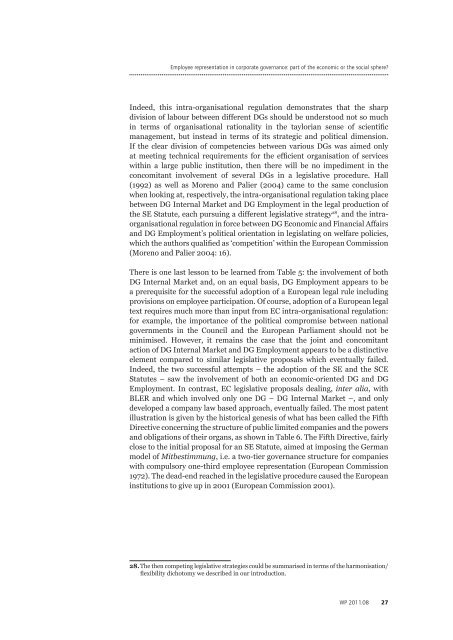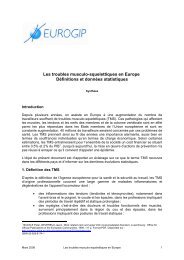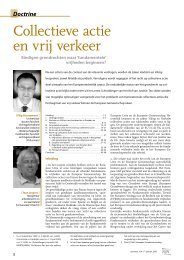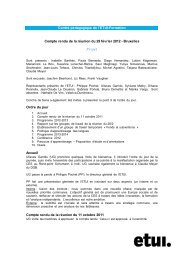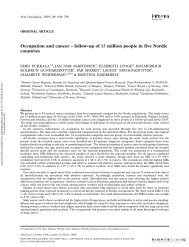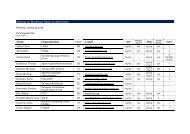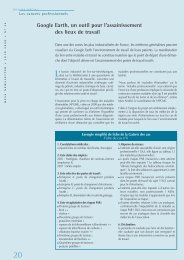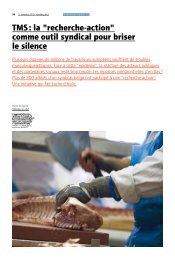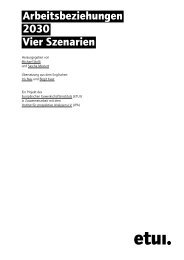Full text - European Trade Union Institute (ETUI)
Full text - European Trade Union Institute (ETUI)
Full text - European Trade Union Institute (ETUI)
Create successful ePaper yourself
Turn your PDF publications into a flip-book with our unique Google optimized e-Paper software.
Employee representation in corporate governance: part of the economic or the social sphere?<br />
Indeed, this intra-organisational regulation demonstrates that the sharp<br />
division of labour between different DGs should be understood not so much<br />
in terms of organisational rationality in the taylorian sense of scientific<br />
management, but instead in terms of its strategic and political dimension.<br />
If the clear division of competencies between various DGs was aimed only<br />
at meeting technical requirements for the efficient organisation of services<br />
within a large public institution, then there will be no impediment in the<br />
concomitant involvement of several DGs in a legislative procedure. Hall<br />
(1992) as well as Moreno and Palier (2004) came to the same conclusion<br />
when looking at, respectively, the intra-organisational regulation taking place<br />
between DG Internal Market and DG Employment in the legal production of<br />
the SE Statute, each pursuing a different legislative strategy 28 , and the intraorganisational<br />
regulation in force between DG Economic and Financial Affairs<br />
and DG Employment’s political orientation in legislating on welfare policies,<br />
which the authors qualified as ‘competition’ within the <strong>European</strong> Commission<br />
(Moreno and Palier 2004: 16).<br />
There is one last lesson to be learned from Table 5: the involvement of both<br />
DG Internal Market and, on an equal basis, DG Employment appears to be<br />
a prerequisite for the successful adoption of a <strong>European</strong> legal rule including<br />
provisions on employee participation. Of course, adoption of a <strong>European</strong> legal<br />
<strong>text</strong> requires much more than input from EC intra-organisational regulation:<br />
for example, the importance of the political compromise between national<br />
governments in the Council and the <strong>European</strong> Parliament should not be<br />
minimised. However, it remains the case that the joint and concomitant<br />
action of DG Internal Market and DG Employment appears to be a distinctive<br />
element compared to similar legislative proposals which eventually failed.<br />
Indeed, the two successful attempts – the adoption of the SE and the SCE<br />
Statutes – saw the involvement of both an economic-oriented DG and DG<br />
Employment. In contrast, EC legislative proposals dealing, inter alia, with<br />
BLER and which involved only one DG – DG Internal Market –, and only<br />
developed a company law based approach, eventually failed. The most patent<br />
illustration is given by the historical genesis of what has been called the Fifth<br />
Directive concerning the structure of public limited companies and the powers<br />
and obligations of their organs, as shown in Table 6. The Fifth Directive, fairly<br />
close to the initial proposal for an SE Statute, aimed at imposing the German<br />
model of Mitbestimmung, i.e. a two-tier governance structure for companies<br />
with compulsory one-third employee representation (<strong>European</strong> Commission<br />
1972). The dead-end reached in the legislative procedure caused the <strong>European</strong><br />
institutions to give up in 2001 (<strong>European</strong> Commission 2001).<br />
28. The then competing legislative strategies could be summarised in terms of the harmonisation/<br />
flexibility dichotomy we described in our introduction.<br />
WP 2011.08 27


